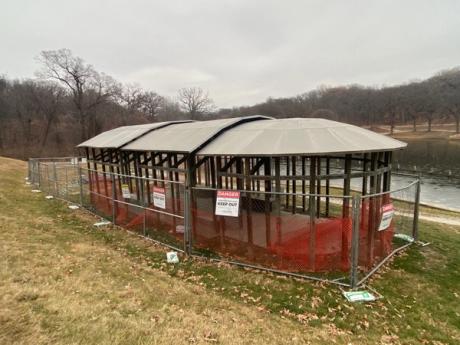
The artist Mary Miss is suing the Des Moines Art Center (DMAC) to block the demolition of her Land art environment Greenwood Pond: Double Site (1996), which the art centre commissioned. The DMAC had recently announced that demolition would begin “on or around” next Monday (8 April).Miss’s lawsuit, filed Thursday (4 April) in federal court in Des Moines, Iowa, accuses the Edmundson Art Foundation (the non-profit that owns and operates the DMAC) of violating the terms of her original 1994 contract for the work’s creation and her rights under the Visual Artists Rights Act. Miss is seeking a restraining order to block the imminent demolition of her work.“The Art Center board and director’s lack of consultation, disregard of their contractual obligations and shameful treatment of the artwork have forced this issue into the courts,” Miss said in a statement. “They have only themselves to blame for this avoidable scandal.”A spokesperson for the DMAC did not immediately respond to a request for comment about Miss’s lawsuit.The art centre recently secured the requisite approval from municipal officials and planned to proceed with the outdoor installation’s demolition, despite a campaign by the artist, her supporters and preservationists to rehabilitate it. In a statement on Wednesday (3 April), the DMAC’s director Kelly Baum framed the decision largely as a public-safety issue.Mary Miss, Greenwood Pond: Double Site, 1996 Photo: © Judith Eastburn, courtesy the Cultural Landscape Foundation“Every decision we make as an institution is for the intellectual, emotional, social and physical well-being of our guests,” Baum said. “Trust and creativity flourish best in environments that are secure and welcoming. We are and always will be just as committed to the arts as we are to public safety.”The art centre has spent almost $1m on maintenance of Greenwood Pond: Double Site over the 28 years since it was completed in Greenwood Park, just south of the institution. The environment consists of a curving boardwalk, a pagoda-like shelter and other structures, all made of wood, concrete and other common building materials. Miss’s environment allows visitors to descend into the titular pond until they are at eye level with its surface.After Baum informed Miss this past October that access to the city-owned site had been suspended following a structural review, the artist told The Art Newspaper that she had sought solutions and made suggestions for securing funding for the needed repairs. On 1 December, she was informed that the museum had decided to deaccession the work. “I was shocked because there had been no further attempt to talk about this,” Miss told The Art Newspaper in January. “I really thought we were going to have a conversation about possibilities.”In a letter sent on 29 March to Jason Gross, the president of the DMAC’s board of trustees, Miss decried “the unseemly effort to destroy Greenwood Pond: Double Site” and accused the museum of misrepresenting a passage in a letter she had written in 2012 about the site’s restoration as granting it permission to demolish her work.“My one conditional remark about removal, made in the context of a possible partial disassembly, is being mischaracterised,” she wrote. “Let me be clear, that remark is not a ‘green light’ from me that gives the board of trustees cover for the current proposed demolition. The claim otherwise is dishonest and manipulative.”Mary Miss, Greenwood Pond: Double Site, 1996 Photo: © Mary Miss, courtesy the Cultural Landscape FoundationIn the letter, Miss adds that the terms of her initial contract with the DMAC from 1994 state that the art centre would not alter the work in any way without her “prior written approval” and would notify her of “any proposed alteration” to the site, consulting with her in order to “make a reasonable effort to maintain the integrity of the work”.“The Des Moines Art Center does not have my written permission to ‘intentionally damage, alter, relocate, modify or change’ Greenwood Pond: Double Site,” her letter concludes (emphasis hers). “Let’s start anew and find a solution of which we can all be proud.”A notice posted to the DMAC’s website on Wednesday (3 April) states that Miss’s work has “regrettably, come to the end of its serviceable life” and outlines the timeline for its demolition. A fence will be erected around the work “on or around” 8 April, after which the pond will be drained and the art centre’s contractor “will disassemble and remove all of the stone, concrete, wooden and metal elements that comprise Greenwood Pond: Double Site, including the boulders, bridges, walkways and huts that either ring Greenwood Pond or sit in it”. This is expected to take 12 to 15 weeks to complete, depending on the weather. The art centre will retain the stone placard for Miss’s work.“The current leadership of the Des Moines Art Center has offered no alternatives to demolition and has brought the city along on the idea that this misguided and highly unethical action is just a routine business decision,” Charles A. Birnbaum, the president and chief executive of the Cultural Landscape Foundation—an education and advocacy organisation based in Washington, DC—said in a statement.


























